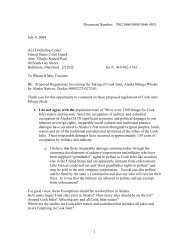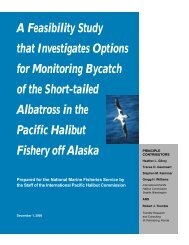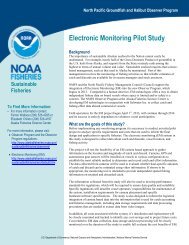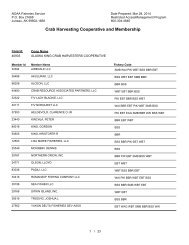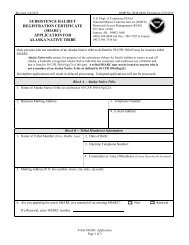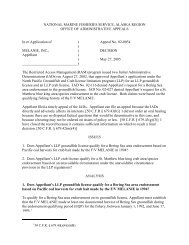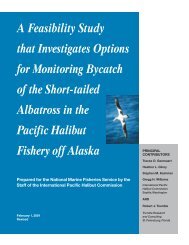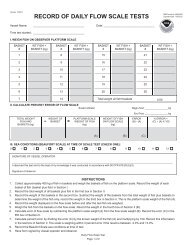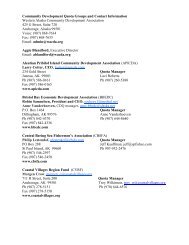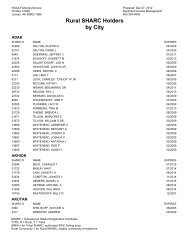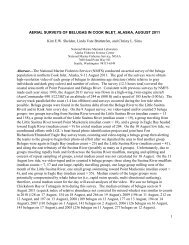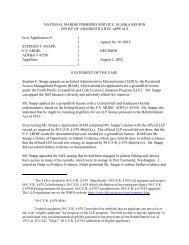Petition to List Lynn Canal Pacific Herring under the Endangered ...
Petition to List Lynn Canal Pacific Herring under the Endangered ...
Petition to List Lynn Canal Pacific Herring under the Endangered ...
You also want an ePaper? Increase the reach of your titles
YUMPU automatically turns print PDFs into web optimized ePapers that Google loves.
(O’Connell et al. 1998: 155)<br />
B. Comparison with <strong>Pacific</strong> <strong>Herring</strong> Populations in British<br />
Columbia; Beacham et al. (2002).<br />
Beacham et al. (2001, 2002) analyzed <strong>the</strong> population structure of <strong>Pacific</strong> <strong>Herring</strong> in<br />
British Columbia using microsatellite loci and found genetically distinct populations of<br />
herring in two circumstances: 1) timing of spawning, and 2) geographic isolation.<br />
In order for local population differentiation <strong>to</strong> occur, herring spawning in a<br />
particular area must home and be isolated from o<strong>the</strong>r spawning herring through<br />
differences in timing of spawning, or <strong>the</strong> location of spawning must be isolated<br />
from o<strong>the</strong>r spawning areas, or both may occur.<br />
(Beacham et al. 2002).<br />
First, differences in timing of spawning by specific herring populations is thought <strong>to</strong><br />
provide reproductive isolation and in turn produce genetic differentiation.<br />
Differences in timing of spawning may have led <strong>to</strong> some genetically discrete local<br />
populations of herring. <strong>Herring</strong> spawning in Skidegate Inlet spawn later than in<br />
o<strong>the</strong>r locations sampled in British Columbia and sou<strong>the</strong>ast Alaska (samples<br />
collected April 15-18, 1998; May 7, 1999), and this later timing of spawning has<br />
provided enough reproductive isolation for genetic differentiation <strong>to</strong> occur.<br />
<strong>Herring</strong> spawning at Secret Cove in <strong>the</strong> Strait of Georgia tend <strong>to</strong> spawn somewhat<br />
earlier than in o<strong>the</strong>r locations in <strong>the</strong> Strait (sample collected March 2, 1999),<br />
perhaps enough of an isolating mechanism <strong>to</strong> allow for genetic differentiation.<br />
<strong>Herring</strong> spawning at Cherry Point, Washing<strong>to</strong>n were sampled May 2, 2000,<br />
approximately two months after spawning typically begins in <strong>the</strong> Strait of<br />
Georgia. This difference in timing of spawning has likely led <strong>to</strong> <strong>the</strong> observed<br />
genetic differentiation between Strait of Georgia herring and those from Cherry<br />
Point.<br />
(Beacham et al. 2002). Second, geographic isolation is thought <strong>to</strong> produce reproductive<br />
isolation and in turn genetic differentiation.<br />
Geographic isolation may also have led <strong>to</strong> differentiation of local populations.<br />
<strong>Herring</strong> spawning in Esquimault Harbour at <strong>the</strong> extreme sou<strong>the</strong>rn end of<br />
Vancouver Island move in <strong>to</strong> Portage Inlet (where samples were collected) prior<br />
<strong>to</strong> and just after spawning. As <strong>the</strong>re is a restricted distribution of spawning<br />
herring in this area, geographic isolation of <strong>the</strong> spawning population may have led<br />
<strong>to</strong> differentiation of a local population.<br />
(Beacham et al. 2002). Lastly, geographic isolation and spawning time are thought <strong>to</strong><br />
work <strong>to</strong>ge<strong>the</strong>r on some herring populations <strong>to</strong> produce genetic differentiation.<br />
V



